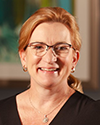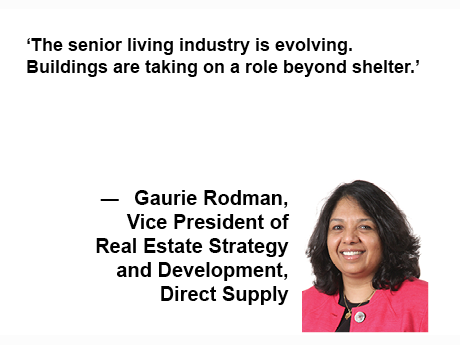While seniors housing operators grapple with occupancy issues, labor challenges and margin squeeze, the building’s role within the industry is sometimes overlooked. But innovative building design and new technologies can help improve staff efficiency, optimize resident care and increase revenue.
“The senior living industry is evolving,” says Gaurie Rodman, vice president of real estate strategy and development at Direct Supply, a provider of equipment and services to the senior living and healthcare industries. “Buildings are taking on a role beyond shelter.”
New building designs are being created through an efficiency lens, utilizing technology to create time savings for staff to allow for more time with residents, as well as a wellness lens, to keep residents and staff healthy. Today’s designs include more technological advancements, more natural light, fresh air, access to comfortable outdoor spaces and features that encourage movement and independence.
Leveraging Technology and Design for Enhanced Staff Efficiencies and Resident Independence

Liz Jensen,
Direct Supply
Where to start to encourage this positive approach to health? It’s a question operators ask as they face a growing and sometimes confusing array of technology and design product offerings. “First, we think about the problems providers are seeking to solve and the impact a tech solution could have,” says Liz Jensen, clinical director at Direct Supply. Jensen analyzes various healthcare jobs to understand what drives staff workflow efficiencies and how the building and its integrated technologies and design can enhance residents’ well-being.
Jensen partners with a senior living clinical collaborative of 50 of the top nursing executives in assisted living as well as Direct Supply’s Innovation and Technology Center (ITC) to generate new ideas and analyze impact. Fall detection and prevention systems, smart cameras, radars, sensors and artificial intelligence are just some of the innovative technologies demonstrating meaningful impact.
Ensuring strong Wi-Fi is often the best place to start, and leaning into Bluetooth-enabled devices can make implementation easier. These devices can integrate seamlessly with the building, allowing for flexibility in small spaces and reliance on already integrated Internet systems. The DS smart® technology platform by Direct Supply, for example, allows caregivers to instantly capture and connect resident health data like vital signs devices, weight scales, blood pressure monitors and other handheld devices to their Bluetooth-enabled electronic-medical-record-connected equipment. Studies show that this solution can reduce time spent on vitals collection by up to 40 percent.* “That’s time saved that can be spent on quality improvement and engaging more with residents,” says Jensen.
From a design perspective, wayfinding — design that uses signs, colors, textures and elevation to improve navigation — can help tenants navigate more independently. Clear signage and wayfinding materials, like 3D texture panels, are a good place to start. By combining color and texture into a wayfinding material, the panels help guide residents as well as boost mood and increase calmness. Considerations of paths and ways to subtly guide residents can increase independence for residents and create time savings for staff. To be effective, wayfinding should be considered early in the design process.
New and Trending Senior Living Technologies

Zane Davis,
Direct Supply
After a severe labor shortage during the pandemic, the availability of staff is gradually improving. Even so, the demand for care and caregivers has continued to increase according to Zane Davis, program development marketing manager at Direct Supply. Davis oversees new solutions coming out of Direct Supply’s ITC in downtown Milwaukee. Direct Supply’s ITC focuses on developing new and innovative solutions in partnership with customers and tech companies alike to automate routine tasks so staff can concentrate on what matters most: interactions with residents.
One example is Servi, a self-driving dining room robot. It carries food from the kitchen to the dining room, while staff come to the table to serve the food from the robot’s trays. Once the table is ready to be cleared, the staff can place the dishes back on the robot for return to the kitchen. “Servi allows the staff to stay with residents,” says Davis. “Also, your current staff can serve even more people.”
Another example is Setpoint, a software program that automates the building’s HVAC system to reduce heating and cooling expenses by up to 45 percent and is compatible with a variety of HVAC systems. Staff no longer need to go room to room to check and set the temperature. They can set a specific range to accommodate personal preferences while standardizing the temperature and, therefore, reducing costs.
Follow the Building as a Caregiver Trend
With a continued focus on staffing challenges, considering the building as a part of your caregiver team by implementing technology and design solutions is essential for developing efficiencies for your team and more time spent with residents. The challenge? Looking beyond immediate costs. To set your community up for success, it’s important to consider the long-term outcomes. Will new technology or a better building design improve staff efficiencies and reduce staff turnover? Will it improve resident satisfaction and therefore boost census?
Jensen encourages owners and operators to take time to understand the pain points in the workplace. Find the bottlenecks. Map out workflows. Find a vendor that’s a reliable partner for the long term. “The ROI on technology investments may be realized in different ways. I encourage providers to include staff satisfaction, impact on turnover rates, quality of care metrics, as well as resident and family satisfaction in their calculations. How will the impact of the technology investment be realized through these critical lenses? A broader view will be required,” says Jensen.
— By Sarah Daniels. This sponsored content was written in conjunction with Direct Supply.
* Savings calculated based on a study in May 2018, focused on the documentation of time savings for caregivers when replacing manual entry of vital signs data with an EMR with automated documentation using the DS smart® solution with 855 residents. Vitals were taken 1.5 times per day. Case Study: “Time Savings” By Scott Boyce, MBA; Brandon Dey; and Liz Jensen, RN, MSN, RN-BC.

